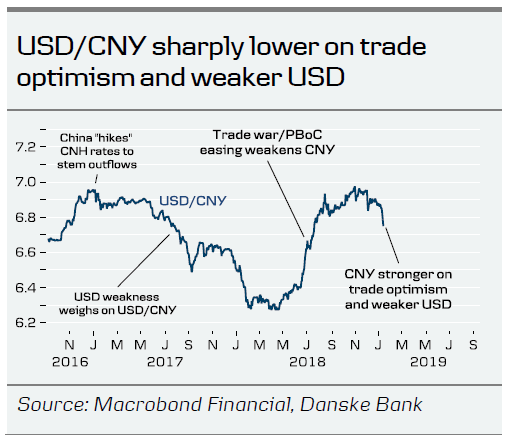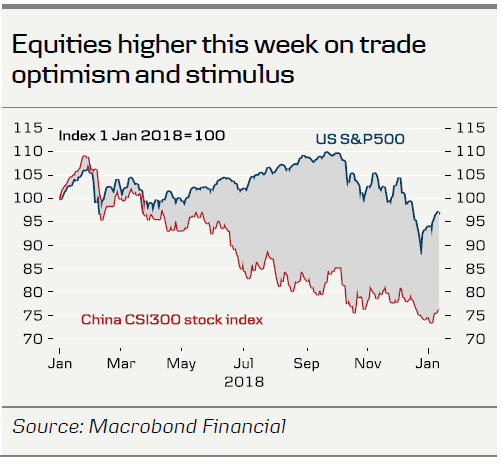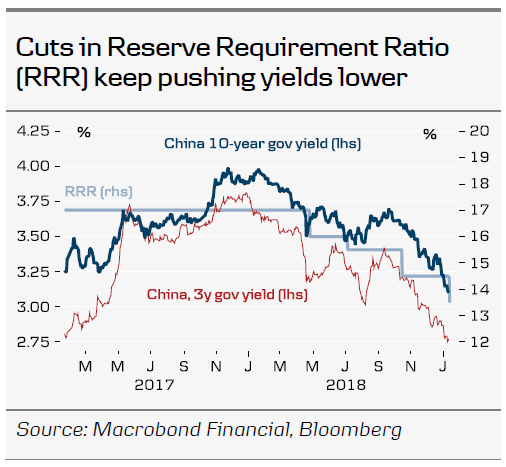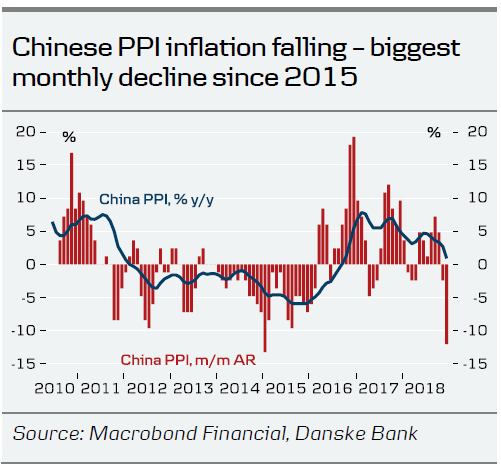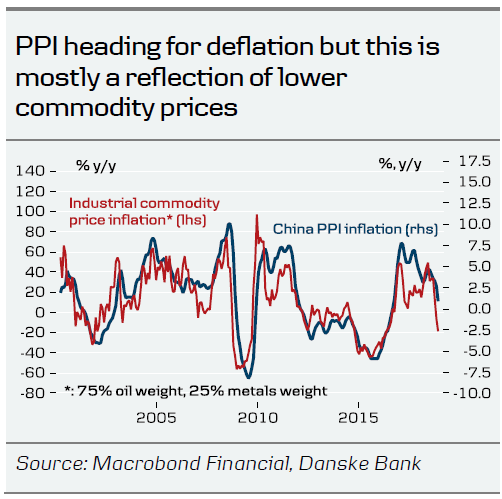- Big move higher in CNY – the tide has turned for the Chinese currency.
- Trade talks on track – Liu He set to go to Washington later this month.
- Stimulus is coming for consumers and small businesses.
- Producer price inflation is heading for deflation territory.
Big move lower in USD/CNY – the tide has turned
USD/CNY moved sharply lower this week to 6.74, after flirting with the 7-level only two months ago. We see two main drivers behind the stronger CNY: (1) rising optimism about a trade deal with the US and (2) an overall weakening of the USD on the back of more dovish speeches by Federal Reserve members that suggest it will be on hold for a while.
Comment : We believe the tide has turned for the CNY and the significant depreciation pressure is turning into a moderate strengthening trend. A halt to the weakening of the CNY is also likely to be part of a trade deal with the US. If we are right that they strike a trade deal and the Chinese economy recovers gradually from Q2, then the CNY should see more tailwind ahead. We plan to publish our latest forecasts in FX Forecast Update – January 2019 on Monday.
Trade talks on track – top-level negotiations later this month
The US and China wrapped up another round of trade negotiations in Beijing this week, with the mid-level talks being extended by one day. The extension is seen as a sign of a commitment on both sides to push forward as needed to reach a deal. Donald Trump tweeted during the talks that ‘Talks with China are going very well!’. China stated that the meetings were ‘extensive, in-depth and detailed’ and laid the foundation for a resolution of the conflict (see Bloomberg , 9 January).
The talks seemed to be mostly on technical issues such as Chinese purchases of US products within agriculture, energy and some manufacturing products, while the bigger hurdles are left for higher level officials. China’s head of the negotiations, economic tsar and vice-President Liu He, is scheduled to meet with US Trade Representative Robert Lighthizer in Washington later in January. Some reports suggest 30-31 January (see The Straits Times , 11 January). Surprisingly, Liu He showed up shortly at the negotiations in Beijing, which added to the sentiment that talks were constructive, as there was no official at the same level from the US delegation.
North Korea’s leader Kim Jong-Un visited China this week on his birthday. It was seen by some as putting pressure on Trump to make a deal (see New York Times , 8 January). Kim Jong-Un and Xi Jinping discussed a summit between Kim and Trump expected to take place soon (see Reuters , 8 January). According to state media in North Korea, Xi Jinping accepted an invitation to visit the country (see SCMP , 10 January).
China gave the long-awaited approval of US exports of five genetically modified crops this week (see Reuters, 8 January). This was seen as a further sign of goodwill from the Chinese side to accommodate the negotiation atmosphere. On a similar note, Citigroup is on track to set up a majority-owned securities joint venture after China has opened up further for investments in the financial area (see Reuters, 8 January).
Comment: We continue to look for a trade deal within three to six months. It should be positive for equities and pave the way for a gradual Chinese economic recovery. So far, talks do not seem to have met any big bumps in the road. There are still some hurdles to be sorted out when it comes to Chinese subsidies and industrial policy, which could delay a deal beyond the ceasefire deadline of 1 March. However, both Trump and Xi seem keen on getting a deal and ending the trade war and we believe they can reach a compromise on the thorny issues. Trump is set to get important ‘gifts’ for key voters in several swing states, as China is set to buy more agriculture products and keep the lower 15% tariff rate on cars.
Stimulus to support consumers and small businesses
China plans to introduce policies that will boost consumer spending on autos and home appliances this year (see SCMP, 10 January). It has also announced further measures to support small and micro businesses. China plans to reduce the tax burden for these companies by USD29bn per year for the next three years (see Bloomberg, 9 January). One of the measures is a reduction in corporate income tax to 5% for income up to CNY1m and 10% for income from CNY1m to CNY3m.
That China is putting more focus on the quality of growth is evident from the news this week that it has reduced the growth target for 2019 to 6.0-6.5% from the target in 2018 of ‘around 6.5%’ (see SCMP, 11 January).
Comment: China is progressing with its piecemeal fiscal stimulus to underpin the private economy, as consumers and private sector companies have reduced spending due to higher uncertainty and tight credit availability. We are not likely to see a big fiscal stimulus plan as in 2008/09 but more measures on a step-by-step basis. We are still awaiting an announcement on tax cuts for consumers. The monetary easing has fuelled a big decline in bond yields (see chart on previous page). We look for growth bottoming in Q1 and recovering gradually from Q2 (see China Leading Indicators – Darkest before dawn, 3 January).
Other China news
Producer price inflation (PPI) decreased more than expected in December, falling to 0.9% y/y (consensus 1.6% y/y) from 2.7% y/y in November. The monthly decline was the biggest since 2015 (see middle chart on the right). We expect the annual rate to dip into deflation territory in coming months due to the fall in commodity prices (see bottom chart).
Xi Jinping may be readying for a long-awaited plenum meeting of the Central Committee of the Communist Party this month (see Bloomberg, 9 January). There has been speculation that the delay may be due to disagreements at the top of the Party. However, it may also have been to keep flexibility on trade talks with the US in December.
Huawei has unveiled cutting-edge ‘big data’ chip, as China pushes for reduced reliance on technology imports (see SCMP, 7 January).
The head of China’s tech ministry has called for enterprises to support core technology (see Technode, 7 January). Although China has made some changes to the Made in China 2025 strategy, there is no doubt in our minds that technology and innovation will continue to take centre stage in China’s development for years to come.




